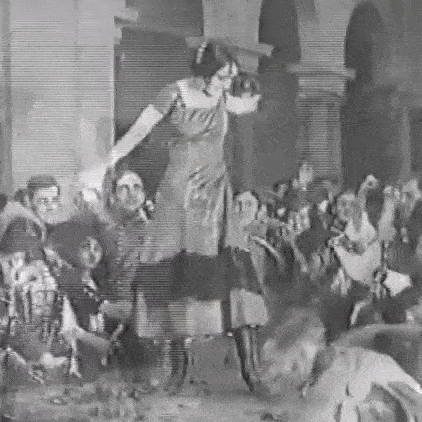POLA NEGRI:
THE FIRST PHASE OF STARDOM
Put simply, Pola Negri is a minefield. A self-fabulist extraordinaire, her ghostwritten 1970 autobiography, Memoirs of a Star, is largely a fantasy of what Negri wanted people to believe rather than an accurate reflection of her life and career. The damage it’s done over the years has been acute, and separating fact from fantasy continues to dog Negri scholarship. First, there’s the problem of her multi-national career, which no scholar has satisfactorily negotiated, given the need for familiarity with Polish, German, and English primary sources. Complicating matters, Negri’s penchant for self-publicity fed the voracious Hollywood press machine but distorted the truth and often eclipsed her considerable talent. Her movies with Lubitsch are largely well-known and justly celebrated, yet the majority of films she made in the U.S. after emigrating in 1922 are understudied or lost. Film scholar Diane Negra, in her 2001 essay on Negri (one of the very few to analyze Negri as both movie star and commodity), talks of the “failure of Negri’s American career,” an assessment that’s long been taken as received wisdom: film star Pola overshadowed film actress Pola, buried under an avalanche of continental exoticism and celebrity lovers. One need only glance at the titles of the two most recent biographies to get a sense of how she’s still being treated: Mariusz Kotowski’s Pola Negri: Hollywood’s First Femme Fatale (English edition 2014) and Sergio Delgado’s Pola Negri: Temptress of Silent Hollywood (2016). As Theodore Dreiser wrote, “Pola Negri is an outstanding example of the sacrifice of a star to commercialism.”
The purpose of our programme is to reassess Negri’s talent, much as studies of the Italian divas, or Asta Nielsen, have granted authorial stature to those actresses. Crucial to an understanding of Negri onscreen is an awareness of her training as a dancer. Watch how she moves in the three films screening this year, and you immediately sense a dancer’s grace. Her magnetism was evident from the very beginning, as testified by noted author Stanislas Rzewuski’s review in the French daily Comœdia (9 January 1913) of the 15-year-old Negri’s theatrical debut, in Aleksander Fredro’s classic play Śluby panieńskie (Maidens’ Vows) in September 1912: “This opening event coincided with the dazzling début of a young artist, Mlle Pola Negri, whose talent, charm, sweetness and rare qualities of intelligence and diction delighted the public and critics alike.”
She entered films in 1914, but World War I held up international appreciation of her talent; this changed with the overwhelming success of Madame Dubarry (1919), the first of a glut of Negri titles released after the Treaty of Versailles. In Italy, critics expressed pride, thinking she was a native daughter (not an unreasonable assumption given that she chose her surname due to a fondness for the Italian poet Ada Negri); then they thought she was German, which complicated matters considering the War was still so fresh. Earlier titles now found distribution, including Carmen (1918), on Italian screens in autumn 1920, which received a rhapsodic review in La Rivista Cinematografica: “…there is no Italian actress who would even dream of approaching the talent of this German artist…. [F]ive minutes after she passes before your eyes, so confident in her performance, so spirited in her interpretation – unquestionably the result of profound observation, study and understanding – she first startles you, then bewitches you immediately after…. And all this is seen in her facial gestures, in the vain contraction and thrashing of her hand, in her magnificent eyes….”
The three Negri films we’re screening, all from 1918, offer an opportunity to look closely at a major actress entering her first phase of stardom. All the traits that captivated her peers are fully in evidence: the beguiling smile, flirtatious and defiant; the fiery gaze; and the thrilling body language, surprisingly graceful and nimble. Also notable is her poignancy in conveying wounded pride and lost love. Vittorio Martinelli, in Le dive del silenzio, wrote that Negri was at her best when playing women of similar temperament and sensuality, such as Carmen, Dubarry, Sappho – women marked by a “physical blend of languor and determination.” He’s not alone in suggesting that this decidedly European mix didn’t transfer well to the United States, though her American career desperately needs reassessment. Fay Wray, whose autobiographical honesty stands in stark contrast to Pola’s, writes of the way Negri’s personality was bleached in Hollywood: “she had been ‘groomed and polished’ and her palette of colors scraped away by the company she had joined: Paramount Famous Lasky Corporation.” The trio of films here reveal the actress in all her panchromatic glory, mesmerizing us with her pantomimic range, testifying to the star as artist.
Jay Weissberg
CARMEN [GYPSY BLOOD]
Ernst Lubitsch (DE 1918)
Mer/Wed 4 – 20:30 – Teatro Verdi
DER GELBE SCHEIN [THE YELLOW TICKET]
Eugen Illés (DE 1918)
Dom/Sun 1 – 20:30 – Teatro Verdi
MANIA. DIE GESCHICHTE EINER ZIGARETTENARBEITERIN
Eugen Illés (DE 1918)
Ven/Fri 6 – 22:30 – Teatro Verdi
- 16 March 2017


 Italiano
Italiano